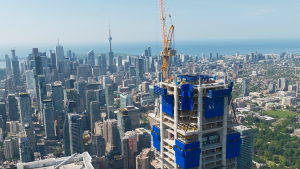Two generations have grown up since the death of Marilyn Monroe, the movie actress whose curves defined on-screen sexiness for millions in the 1950s.
It may seem strange to we old folk, but there are probably many under the age of 40 who have never heard of her. Yet when the Absolute Towers in the Toronto suburb of Mississauga began to take shape, people who remembered Monroe quickly dubbed the project the “Marilyn Monroe” building because of its sexy curves.
It’s actually two buildings, one of 56 storeys, the other of 50, and they attracted a lot of attention while they were under construction.
Now, the project is attracting attention again.
The Council on Tall Buildings and Urban Habitat, a global organization headquartered in Chicago, has just released its list of the Best Tall Buildings for 2012, and the winner for the Americas is Absolute Towers, the “Marilyn Monroe” building.
The other global winners were a building in Australia (for Asia and Australia), one in Milan (for Europe) and one in Doha (for the Middle East and Africa). An over-all winner will be named this fall at the council’s annual awards dinner.
The design architect for the Absolute Towers was MAD Architects. Associate architect was Burka Architects. Structural engineering was by Sigmund Soudack, and mechanical-electrical engineering was by Stantec.
There were two runners-up named for the Americas: Jameson House, a mixed-use tower of 36 storeys, in Vancouver, and an office tower in Houston. Foster + Partners was the design architect for Jameson House, with Walter Franci Architecture Inc., as associate architect. Structural engineer was Halcrow Yolles, a CH2M Hill company, and electrical and mechanical engineering by Imec Mechanical.
There were 78 projects entered from all over the world, and they were judged by a panel of industry executives. A news release said the judges were looking for projects making an “extraordinary contribution to the advancement of tall buildings and the urban environment, and for achieving sustainability at the broadest level.”
These awards were for buildings completed in 2011. But with so many buildings reaching for the sky, one can’t help but ask what constitutes a tall building nowadays.
The council has published criteria for defining and measuring tall buildings, which begins by saying that there is no absolute definition. Context makes a difference. Thus a 15-storey building in the heart of Toronto might not be considered tall, but if that same building were to go up in a much smaller city, it almost certainly be thought of as tall.
Technology is important, as well. For example, if structural wind bracing is used as a result of height, a building could be classed as tall.
Generally speaking, however, a building more than 50 metres tall could be considered tall. That means perhaps 14 or 15 storeys.
Then, of course, there are the supertall buildings, which are usually more than 300 metres in height. There aren’t many of these — only 54 listed in the world when the count was done in the middle of last year.
The council also keeps track of other tall structures, including communications towers.
Torontonians for a long time took pride in the fact that the CN Tower was, at 553 metres, “the world’s tallest free-standing structure.” No more. That prize now goes to the Tokyo Sky Tree, at 634 metres. Second place is the Canton Tower in Guangzhou, China. It’s 600 metres tall.
If you’re interested in the Council for Tall Buildings and Urban Habitat, you can find them at www.ctbuh.org
They have compiled a database on tall buildings that may be useful for some folks, and is fun to browse simply to see who’s building the tall stuff and where. You can also get on their mailing list as a way of keeping a watch on tall buildings.
Korky Koroluk is an Ottawa-based freelance writer. Send comments to editor@dailycommercialnews.com











Recent Comments
comments for this post are closed